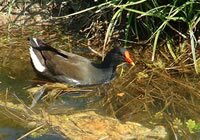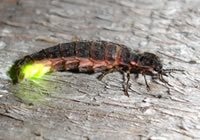

Canal from Aldergate bridge
The majestic mute swan can be found all along the canal as can the grey heron, as it waits patiently to make the most of the canal?s bountiful fish stocks. A flash of blue or orange darting low over the water will indicate the presence of a kingfisher, and a noisy cuffuffle from the reeds or a loud squawk will probably be a moorhen nervously making its way through life. Throughout the summer months the quarrelsome song of the reed warbler can be heard as it goes about its life unseen in the reeds.
As leaves begin to unfurl and a warmth hangs in the air blossom can be seen appearing on the trees along the northern bank of the canal. Elms were the first trees to be planted there, but others like cherry, sycamore, poplar and maple have been planted since. During the summer the canal supports a profusion of yellow flowers: the yellow flag iris stands proud in the muddy shallows, while the fringed water lily and bladderwort float on the canal?s surface.
In the summer the emperor dragonfly can be seen patrolling along the canal, an eerie reminder of the one time imminent Napoleonic invasion. The long warm evenings are perfect for glow worms, who light up the banks along certain stretches of the canal, serenaded by the laughing call of the marsh frog.
The back drains and adjacent ditches of the canal provide an ideal habitat for the endangered water vole, which requires high water levels and thick bank side vegetation to survive. The main channel of the canal is more suited to the mink - a good swimmer and a voracious predator - which was introduced to this country in the 1930s. The high, tree covered banks of the defensive parapet have provided an ideal home for badgers. As night-time approaches they can be found snuffling around, looking for earthworms, grubs and bumblebee nests.
The importance of the Royal Military Canal for wildlife has led to part being designated a Site of Special Scientific Interest (SSSI), with the remaining length designated a Local Wildlife Site.
If you would like to report any wildlife you see while walking along the canal, the Romney Marsh Countryside Project would be only too glad to hear from you. You can email us at or call 01797 367934.
For more information about wildlife on the Romney Marsh click here
Birds
Mute Swan Cygnus olor
The mute swan breeds all along the canal and can be seen there all year round Mute swans pair for life and are often seen gliding along the canal as a family unit.Young swans are distinguishable by their dirty-brown plumage and can take several years to mature, when they gain the magnificent white plumage of the adults. Male birds have a larger knob at the base of the beak than females. In winter, the swans take to the arable fields where they feed on the crops.
Grey Heron Ardea cinerea
Its large size, long legs, mainly grey plumage and long, dagger-like bill identify the grey heron. It is found all along the canal and is often seen standing alone in the water, stealthily waiting for a fish supper. Although they mainly feed on fish and amphibians, it is not unknown for the heron to take a small mammal or water bird. Grey herons are communal nesters, and in Lympne Park Wood, alongside the canal at West Hythe, there is a heronry. Here they breed in large nests in the tops of trees, returning to the same nest each year. Herons breed early in the season so that the young hatch in time to make the most of the breeding season of frogs and newts. In February, before the trees have got their leaves, you can see herons in their nests incubating their eggs.
Kingfisher Alcedo atthis
The kingfisher is usually seen in flight as a flash of blue or orange. This colourful bird, with its bright orange underparts and blue upper parts, feeds on small fish and is a regular resident along the whole of the canal. Kingfishers are small birds, much smaller than a thrush; they fly fast and low over the water with rapid, whirring wings and often perch on branches just above the water. When feeding their young they need to catch around 12-18 fish a day; the young are reared in a burrow in the bank.
Moorhen Gallinula chloropu
Moorhens are slightly smaller than a duck and, with their sharp red beaks with a yellow tip and dark plumage with white flank and undertail, are unmistakable. The moorhen is a very common bird of lakes, rivers and streams and can be found all along the Royal Military Canal. They can run, walk, swim and dive with equal efficiency, although they have a rather weak, fluttering flight.
Trees and Plants
Elms Ulmus procera
Elms were the first trees to be planted along the canal?s parapet in order to stabilise it. Elm was chosen because of the value of its timber: a good hard wood which does not split when being worked. The English elm is a tall deciduous tree with rough bark which flowers in February and March before the leaves are open - the reddish haze on the bare twigs creates a distinctive sight. Elms can be easily identified by their leaves, which do not meet up evenly on the stalk. Unfortunately elms have suffered greatly from Dutch Elm Disease - a fungus which attacks the water carrying vessels inside the tree (xylem) - although young suckers can be seen growing back from the roots in many places.
Yellow Flag Iris Iris pseudacorus
The yellow flag iris is a common plant of marshes, wet woods, river and ditches and it can be found along the canal. It can grow to 1.5 metres in height and has bright yellow, flag-like flowers in midsummer; later in the summer it develops enormous seed pods, the seeds of which can be roasted and made into a hot drink like coffee. Iris is the Greek word for rainbow and to the Greeks the plants symbolised life and resurrection.
Fringed Water Lily Nymphoides peltata
The fringed water lily is a floating aquatic plant that flowers in midsummer and covers the surface of the canal in yellow flowers. The leaves are similar, although smaller, to the water-lily and the flowers have distinctive fringed petals. It appears as if the plant is spreading out from the canal banks, but it is tethered to the bed of the canal by a floating stem.
Bladderwort Ultricularia vulgaris
Bladderwort is a rare insectivorous plant that flowers in midsummer, the yellow flower protruding from the water?s surface. The root-like leaves, which are submerged in the water, have tiny bladders which trap aquatic insects to supply the plant with nutrients. It is not to be confused with the yellow fringed water-lily, which has round, floating basal leaves. Bilsington bridge is a particularly good place to see bladderwort on the canal
Insects and Amphibians
Emperor Dragonfly Anax imperator
The Emperor Dragonfly is one of the largest dragonfly species to be found in the UK. This dramatic, bright blue, fast-flying dragonfly enjoys flying low over still water: it can be found patrolling up and down the centre of the canal in midsummer catching flies and midges on the wing. The Emperor lays it eggs in the canal, the larvae feeding on the larvae of flies.
Glow Worm Lampyris noctiluca
On certain sections of the canal, particularly around West Hythe, glow worms can be found. Their ethereal green glow is an unmistakable sight. Glow worms are actually beetles: the flightless female glows brightly in the long grass, positioning her luminous tail segments to attract male glow worms, which can fly. Glow worm larvae feed on snails; the adults do not feed and live on average for only ten days.
Marsh Frog Rana ridibunda
In 1935 the wife of E.P. Smith, MP for Ashford, wanted to surprise him with some edible French frogs to put in the garden. Unfortunately French frogs were unavailable so she bought some large Hungarian frogs instead. These promptly escaped from their garden in Stone-in-Oxney and spread across the ditches of the Marsh with great success: colonising the entire Romney Marsh area by the 1960s.Marsh frogs are the largest European species and can grow to the size of an adult human?s hand. They are usually olive green in colour and, unlike common frogs, rarely venture far from water and can often be seen basking on the canal banks in the summer. Marsh frogs eat a wide variety of invertebrates and will feed under water. Larger individuals will occasionally take small fish and fledgling birds.
Marsh frogs breed in May and June when the distinct cackling call of the males can be heard. This unique sound has given rise to their affectionate nickname of the ?laughing frog?

Mammals
Water Vole Arvicola terrestris
Ratty, from Kenneth Graeme?s ?Wind in the Willows?, is actually a water vole - the largest British vole - and the back drains and adjacent ditches of the canal are ideal sites to look out for this furry mammal. However, over the last 20 years some 97% of the British population has disappeared, making the water vole the fastest declining European mammal. Reasons for the decline include habitat loss through development, insensitive management of watercourses and increased levels of predation from the American mink.Water voles are found close to the water?s edge where they feed on the leaves and stems of a variety of waterside plants. Here they construct an intricate system of burrows with separate food and nest chambers in which the colony live. They breed between March and October producing 2 - 5 litters of 5 - 8 young each year. Water voles do not hibernate and are fairly short-lived, rarely exceeding three years of age.

Mink Mustela vison
The American mink is a dark, ferret like mammal which escaped from fur farms in the 1930?s and established itself along waterways. The vegetated banks of the canal have provided an ideal home for mink which are at home in water. Mink are opportunistic predators feeding on fish, birds, small rodents and particularly rabbits, and, with no natural predators themselves, populations have expanded quickly. There is much concern about the effects of mink predation on native animal species. It is thought that the recent decline in water vole populations is partly due to the presence of mink.